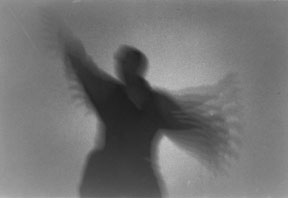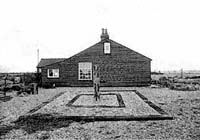ROBERTO
PACI DALÒ
BLUE STORIES
live cinema
based on 'The Desert Book' by Ingeborg Bachmann

Homepage: http://giardini.sm/projects/blue
Author: Roberto Paci Dalo' dalo@giardini.sm
Version: beta
Licence: GPL
Environment: All
Status: Development
A
live cinema and music environment created differently every time,
is the new project of director and performer Roberto Paci Dalò
WHAT
LIVE CINEMA MEANS?
Live Cinema is a further step into the future of cinema. It means that,
through the use of digital tools, it is now possible not only working
on lower cost productions but also dealing with cinema as performing arts.
Bringing back to the emotion of the early cinema through the newest technlogies.
Creating sets where action happens live and with a public. The wish of
many people: being on set of a movie shooting. This is BLUE STORIES.
BLUE BACKGROUND
Yves Klein and Derek Jarman drive me into the world of blue, of vision,
of listening. Together with them the crucial dziga Vertov's work and his
kinoglaz. A 360 degrees work on cinema which reconnects early cinema with
digital technologies in order to produce an old and new craftmanship of
film art. Where - between expanded cinema and new formats we can think
about cinema as time art.
Through the creation of a series of modules both acoustical and visual I develop a series of performances released every time in a different way. Buildings and rooms inhabitated by the cinema which is produced in realtime in performance in front of the audience. Innovative electronica, cities, soundscapes, sampling as basic practices.
The project proceeds accumulating materials and combining fiction cinema with documentary and architectural / urban explorations. In the performance materials are mixed live. A live cinema which brings back to the emotion for the "pre-cinema" made out of camera obscura and laterna magica in a Athanasius Kircher's spirit of fascination for visionaries technologies. I play with expressions and concepts of the Linux world programmers (release, open source) and at the same time music (version, remix).
Blue
Stories' reference text is The Book of Desert by Austrian born writer
Ingeborg Bachmann. This book has been published by the Italian publishing
house Cronopio Edizioni
collecting 2 different texts: Wüstenbuch and Der Tod wird kommen.
This text is the core of the screenplay I'm developping.

BLUE
STORIES' PROCEED EXAMPLE
Here is an example of the proceed I'm following for the performances of
BLUE STORIES.
During the days before the performance - or even the same day -I travel
in the city where the performance will be presented, recording digitally
both sounds and images which will be edited in realtime working with laptops.
Those elements will be part of the materials of the show of the night
playing around with already existing post-produced materials which guarantee
the frame of the performance. Shooting on-site means both places and people.
The performance place becomes a sort of very small movie set with lighting,
cameras, mixing consoles.
Actually
I'm fascinated about the use of digital video which makes possible for
me to re-create the quality and texture of super-8 films. This is why
I'm using digital video both on its highest and 'lowest' standard qualities.
In
the solo performance I mix live videos and I play the music based on electronics
and sampling. From environmental sounds to breathless beat where the sound
deals deeply with perceptional strategies involving fast bpm and particular
frequencies involved i.e. extremely low pitches like 25 Hz in combination
with ultrasounds. A minimal electronica where big space is given to pure
sounds and their relationships with the space.
Together with images from computers' hard disks and tapes, I use micro
infra-red live cameras placed in the performance space. Specific visual
and acoustical softwares are employed in the performance in order to control
in deep parameters involved.
The idea is to work for about a year presenting a number of performances
all around the world. This will build a rather big archive of images and
sounds. At the end of this step it will be possible to edit a movie which
is going to be quite particular and to be screened in movie theatres.

THOUGHTS
"(The Wizard of Oz) is one of my favourite films I must say"
Derek Jarman
from BBC interview
with Jeremy Isaacs
I
waited a lifetime to build my garden,
I built my garden with colours of healing
On the sepia shingle of Dungeness.
I planted a rose and then an elder,
Lavender, sage and Crambe maritima,
Lovage, parsley, santonlina,
Hore hound, fennel, mint and rue.
Here was a garden to soothe the mind,
A garden of circles and wooden hedges,
Circles of stone, and sea defences.
Derek Jarman

I had just removed from my studio all earlier works. The result - an empty
studio. All that I could physically do was to remain in my empty studio
and the pictorial immaterial statesof creation marvellously unfolded.
However, little by little, I became mistrustful of myself, but never of
the immaterial. From that moment, following the example of all painters,
I hired models. But unlike the other, I merely wanted to work in their
company rather than have them pose for me. I had been spending too much
time alone in the empty studio; I no longer wanted to remain alone with
the marvellous blue void which was in the process of opening.
Yves Klein
from The Chelsea Hotel Manifesto
When
filmmaker Derek Jarman (Caravaggio, The Last of England, Blue, and other
films) discovered in 1986 that he was HIV-positive, he decided to construct
a garden at his cottage on the coast of Dungeness, Kent. He
cultivated his garden from 1986 until his death in 1994.
He created the garden outside a fisherman's cottage on the shingle at
Dungeness, in southeastern England, beside a nuclear power plant.
Jarman fashioned stone circles, sculpture out of driftwood and old tools,
and a garden based on indigenous plants plus introduced shrubs and flowers
that could survive in the area's inhospitable environment. Jarman started
by collecting stones from the beachand arranging them in circles; he added
driftwood, antique tools and found objects for sculpture, then put in
native shrubs and flowers. Completed, the garden evokes serenity and pleasure.

WEB
The narrative structure of the project comes from a screenplay in-progress.
Where in each presentation there are new versions, cuts and so on. The
screenplay itself is conceived as a public space. It's possible to follow
on-line the development of the script made out also of 'old school' story
boards.
The Journal of the project includes on-line videos coming from shooting
in every performance place.
WHERE
BLUE STORIES it's an event and process which can be presented in public
space, film festivals, museums, theatres, clubs, and in special out-of-format
venues like large scale industrial buildings or even outdoor.
Where is possible, an Internet connection is active allowing the remix
of webcams from the net and eventually the webcasting of the performance
hosted by other websites as well.
BLUE allows the possibility of video/sound environments to be experienced
as installation
STEPS
Original materials of BLUE STORIES were presented first time December
2000 at the Fondazione Morra (Naples).
A bit earlier I made my first project in Catania where I've somehow created
the praxis of BS shooting all day in different places of the city and
screening the result of this wandering in performance same night. Later
in Rome I did a project together with achitects group Stalker where I
was mixing videos they made with my sounds.
BLUE STORIES is part of the on-going project COSPIRAZIONI created together
with Patrizio Esposito.
Roberto
Paci Dalò, Athens, march 2001